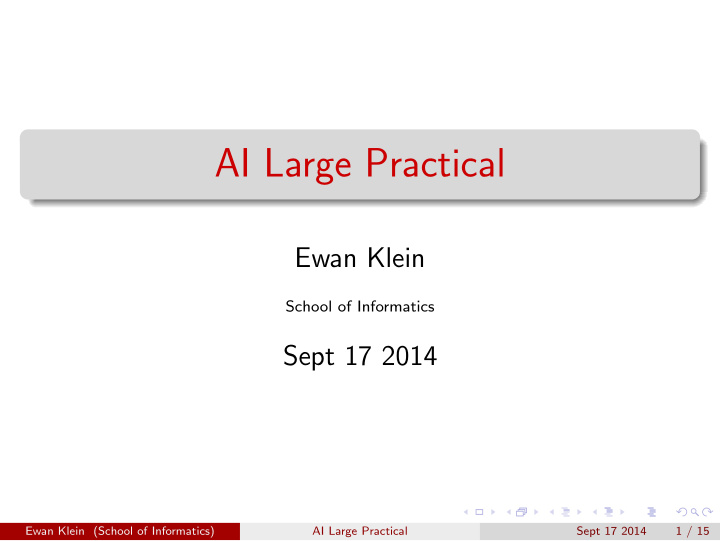



AI Large Practical Ewan Klein School of Informatics Sept 17 2014 Ewan Klein (School of Informatics) AI Large Practical Sept 17 2014 1 / 15
AILP: Course Description The official descriptor is on-line: http://www.drps.ed.ac.uk/14-15/dpt/cxinfr09018.htm ◮ There is no exam for this course; assessment is based entirely on your work during the practical: the programs you write, and your reports of those programs. ◮ The course is compulsory for several degrees. Ewan Klein (School of Informatics) AI Large Practical Sept 17 2014 2 / 15
Course Aims, 1 ◮ Most practical work in the formal curriculum has asked you to solve closely specified problems, in a short time ◮ AILP asks you to manage your time, and organise how you set about a larger task. ◮ You will play a larger role in setting the direction of your work, and in reporting on your work. Ewan Klein (School of Informatics) AI Large Practical Sept 17 2014 3 / 15
Course Aims, 2 AILP is intended as a small introduction to research, which will involve: ◮ Understanding the problem ◮ Reading some associated literature ◮ Designing an extended computational system. ◮ Experimenting and evaluating. ◮ Writing a final report on your work, Ewan Klein (School of Informatics) AI Large Practical Sept 17 2014 4 / 15
Outline Assignment Issue Due Weight A1 24 Sep Fri 24 Oct, 16:00 50% A2 ≤ 29 Oct Thu 12 Dec, 16:00 50% Ewan Klein (School of Informatics) AI Large Practical Sept 17 2014 5 / 15
Sessions Lectures Wednesday, 9:00 in DHT LG.06, weeks 1, 2, 6, 7 — and possibly others Drop-in Mondays, 10:00 in AT 5.08, from week 3? Labs Mondays, 13:00 in AT 4.12, from week 3? Drop-in labs allow you to ask questions about the assignments in general, and about design and programming issues. Ewan Klein (School of Informatics) AI Large Practical Sept 17 2014 6 / 15
Spreading the load You are expected to budget your own time and pace your work to meet the deadlines. Beware There will be other coursework deadlines falling towards the end of the semester. Remember that the AILP submissions count for a lot more than coursework associated with courses with exams. For most people, the period at the end of the semester will be free from other coursework deadlines. Ewan Klein (School of Informatics) AI Large Practical Sept 17 2014 7 / 15
Organisation ◮ If you need to contact me, please use email: ewan@inf.ed.ac.uk ◮ We’ll be using Python this year. ◮ Does it make sense to have student rep for the course? Volunteers? Do read your email! If I need to make announcements, I’ll do it via email to the mailing list for this course. Ewan Klein (School of Informatics) AI Large Practical Sept 17 2014 8 / 15
Reminder: plagiarism Claiming someone else’s work as your own is a serious offence within a university; this includes failure to acknowledge where your work is based upon someone else’s work. ◮ It’s good to discuss problems and ways to solve them with others. ◮ But you must: ◮ Write your own code; ◮ Do your own experiments; ◮ Write your own report. More discussion at http://www.inf.ed.ac.uk/admin/ITO/ DivisionalGuidelinesPlagiarism.html Ewan Klein (School of Informatics) AI Large Practical Sept 17 2014 9 / 15
Area of Practical ◮ The area of the practical is in argumentation systems. ◮ Argumentation involves making sense of arguments both for and against some claim or course of action. ◮ Examples: ◮ Choice of treatment for a patient; ◮ Choice of action by a governing body; ◮ Legal arguments for guilt or innocence; ◮ Individual choice of ‘considered action’ Ewan Klein (School of Informatics) AI Large Practical Sept 17 2014 10 / 15
Area of Practical ◮ The area of the practical is in argumentation systems. ◮ Argumentation involves making sense of arguments both for and against some claim or course of action. ◮ Examples: ◮ Choice of treatment for a patient; ◮ Choice of action by a governing body; ◮ Legal arguments for guilt or innocence; ◮ Individual choice of ‘considered action’ — should I eat the whole tub of ice cream? Ewan Klein (School of Informatics) AI Large Practical Sept 17 2014 10 / 15
Exercise 1 ◮ Write down three examples of arguments. ◮ Reflect on your examples: do the arguments have internal structure, identifiable components? Ewan Klein (School of Informatics) AI Large Practical Sept 17 2014 11 / 15
Exercise 2 ◮ Work with a partner; one of you will be proponent, the other will be opponent. ◮ The proponent selects one of his/her examples from Exercise 1, and puts the argument forward. The opponent tries to rebut the argument with a counterargument. ◮ Now swap roles. Ewan Klein (School of Informatics) AI Large Practical Sept 17 2014 12 / 15
Exercise 3 Next week, we’ll be looking at something called the Carneades model of argumentation. This is partly motivated by the goal of representing legal arguments. ◮ What is the difference between arguments and legal arguments? ◮ Try to come up with a few examples of legal arguments. Ewan Klein (School of Informatics) AI Large Practical Sept 17 2014 13 / 15
Stuff to read Douglas Walton (2009) ‘Argumentation Theory: A Very Short Introduction.’ http://www.dougwalton.ca/papers%20in%20pdf/09ArgShort.pdf Thomas F. Gordon, Henry Prakken, and Douglas Walton (2007) ‘The Carneades model of argument and burden of proof.’ http://www.sciencedirect.com/science/article/pii/ S0004370207000677 Ewan Klein (School of Informatics) AI Large Practical Sept 17 2014 14 / 15
Next Week ◮ Meet at 09:00, same venue; ◮ Assignment 1, and how it will be assessed. Ewan Klein (School of Informatics) AI Large Practical Sept 17 2014 15 / 15
Recommend
More recommend